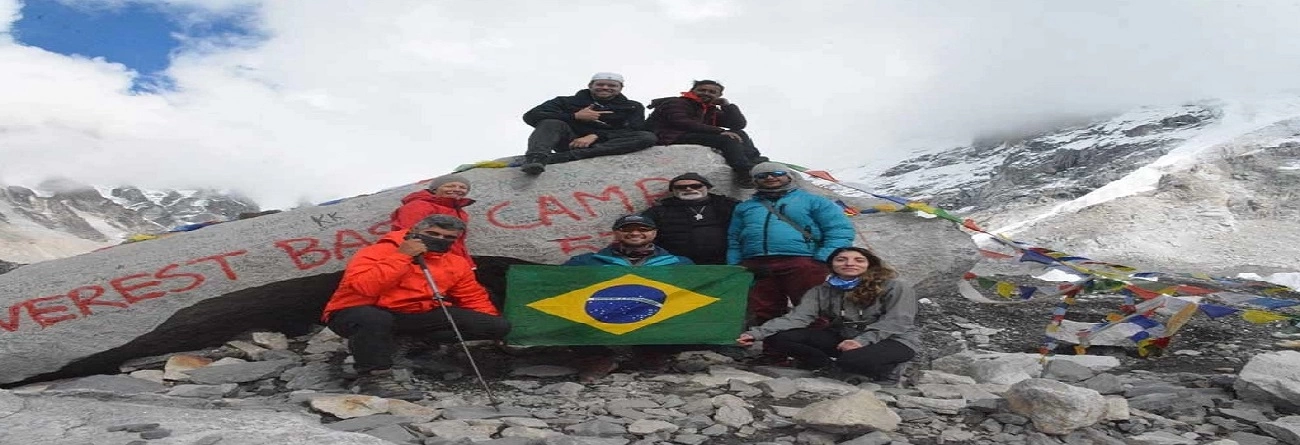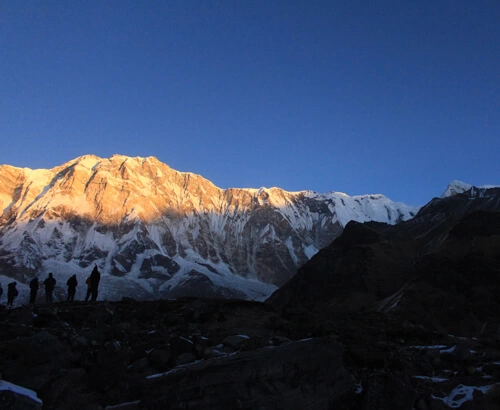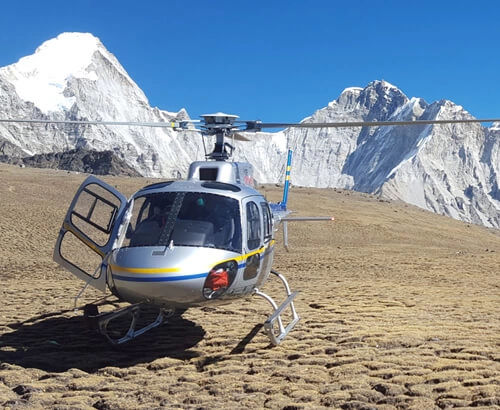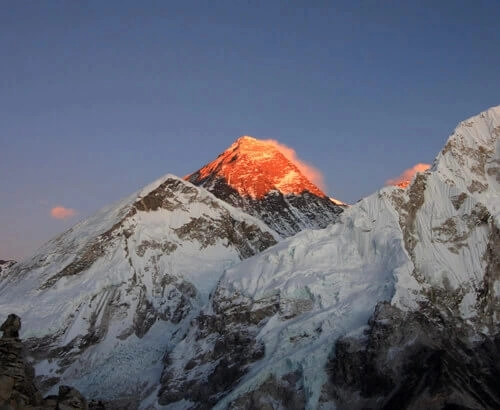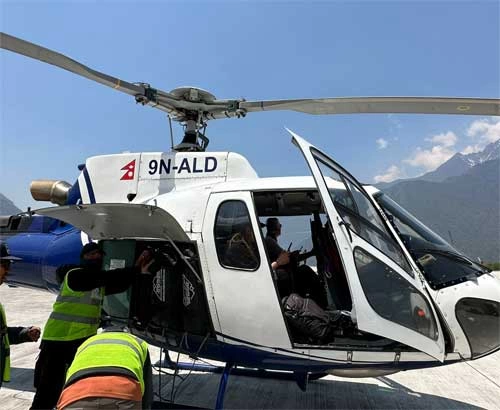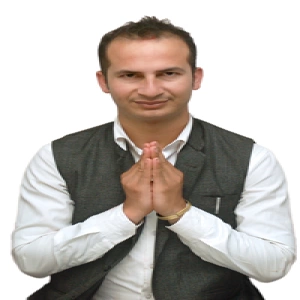Highlights of Everest Base Camp Trek 2024/2025
- Stunning views of the Nepalese Himalayas, including the majestic Mount Everest, Ama Dablam, Cho Oyu, Lhotse, Nuptse, and Island Peak.
- Immerse in the Sherpa culture, exploring charming villages and ancient monasteries like Tengboche and Pangboche Monasteries.
- Pass through Hillary Suspension Bridge, Thokla Pass, Lobuche Pass, and the treacherous Khumbu Icefall.
- Explore Namche Bazaar 'Gate to Everest,' rich in vibrant culture and cuisine.
- Explore flora and fauna inside Sagarmatha National Park, UNESCO World Heritage Site.
- 360 Views of Himalayas from Kala Patthar (5,555m).
- Explore World’s highest airport at Syangboche (3,780m).
- Reach the world's tallest mountain’s base camp.
Prepare First For The Everest Base Camp Trek 2024/2025
Everest Base Camp Trek is a challenging trek, rated treacherous and dangerous that can even cost the lives of trekkers. Nestled in the lap of the Himalayas in Nepal, this trek features hours of hike in the uphill and rugged trails that are very challenging. Similarly, it takes us 5,000 meters above sea level, where human survival is very minimal.
Due to such reasons, there’s always room for preparation before setting off towards the trek. Here are some of the preparations you need to consider:
Physical & Mental Preparation
Your physical fitness is one of the most-have entities for the Everest Base Camp Trek. First things first, Everest Base Camp Trek is not a single day hike, it requires at least 12-15 days to complete. On top of that, the trail is remote, unbeaten, and rugged. And just imagine you walking for 6 to 7 hours daily for 15 days in such landscapes. Isn’t it physically challenging? Of course, it is.
It’s the same reason why we recommend every trekker to prepare physically. Trekkers are recommended to build up their cardiovascular energy as this trek requires hours of hike everyday. Cycling, short hikes, and gym workouts will help you grow physical fitness. Besides, trekkers are urged to have altitude training for we do not want them to face any issues during the high altitude treks like Everest Base Camp.
Apart from all that, having a mental preparedness is crucial for this trek. The weather conditions around the Everest region is unpredictable, which has a direct impact on this trek. Many trekkers are likely to withdraw their interest in reaching the base camp due to extreme weather. Injuries, physical exhaustion, and altitude sicknesses are some other reasons which divert trekker’s minds.
However, we recommend every trekker to be prepared for such circumstances and seek help from professional guides. Carry your own oxygen supplements and monitor the symptoms of altitude sickness. If your body says ‘NO,’ descend to the lower altitudes. Keep your mindset very positive and do not hurry up in the uphill landscapes.
Acclimatization
Acclimatization is the most important thing that needs to be done during the hike. We are known to the fact that this Everest Hike takes us all the way from 2,800 meters to 5,000 meters above sea level. The change in altitude might not be fit for every trekker, resulting in altitude related illnesses like AMS (Acute Mountain Sickness), HACE (High Altitude Cerebral Edema), andHAPE (High Altitude Pulmonary Edema).
To avoid the risks of such high altitude related illnesses, acclimatization is very important. Generally, Acclimatization is a process of adapting into a new altitude and climate. During our trek, we will be acclimatizing at Namche Bazaar and Dingboche Village before reaching the base camp. Here are some tips to acclimatize properly:
- Gradually expose yourself to higher altitudes.
- Stay hydrated and drink plenty of water.
- Allow your body time to rest and adapt to the new environment.
- Monitor your health and be aware of altitude sickness symptoms.
- Dress in layers to stay warm and protect against extreme weather.
Some trekkers even use a medicine called ‘Diamox’ to stay out of the dangers of altitude sickness. But it is only recommended to take such medications under the supervision and prescription of doctors or a physician.
Permits & Logistics
One of the important things to consider during this is permits required. Everest’s camp lies within the UNESCO World Heritage Site, Sagarmatha National Park. It is a natural sanctuary of hundreds of endangered animals, birds, and reptiles. Around 219 species of birds are found in the park, while it gives shelter to rare animals like Snow Leopard, Red Panda, Himalayan tahr, Musk Deer, Marten, Himalayan Mouse Hare (pika), and many more.
So, to track trekker’s activities around the region, the authorities have implemented Sagarmatha National Park Entry Permit, required for the Everest Base Camp Trek. This permit can be purchased from Nepal Tourism Board in Kathmandu or from Monjo Checkpost in Monjo Village.
The cost of the Sagarmatha National Park Entry Permit is NRs. 3000 per person for the international trekkers. It costs NRs. 1000 for the SAARC Nationals while the cost for the Nepalese trekkers is NRs. 100 per person.
Similarly, there is another mandatory permit that is required for this trek. Khumbu Pasang Lhamu Municipality Entry Permit is required to enter the Khumbu Valley. It costs NRs. 2000 per person and it can be purchased from Nepal Tourism Board in Kamaladi, Kathmandu.
Last but not least, the Gaurishankar Conservation Area Entry Permit is also required if you are looking forward to hiking from Jiri to Lukla. Since this trail will touch the landscapes of Gaurishankar Conservation Area, we need to obtain this permit.
Guides And Porters
Guides and porters are another essential entity in any hike. The rule of hiring guides is mandatory for rural trekking in Nepal, which has been implemented since April 1, 2023. There had been a lot of missing and injured cases that questioned the safety of trekkers in rural Nepal. It was the same reason for the implementation of the new rule in the tourism industry. Now, every trekker must hire a professional and certified guide for trekking in Nepal, including Everest Base Camp.
There are many benefits of hiring guides for the Everest Base Camp. First, guides have extensive knowledge about the Everest Region and they can provide insightful knowledge about the places around the trail. Similarly, they are known with the local people, culture, lifestyle, and traditions. It will allow us to immerse ourselves in the diverse culture of the Everest region.
Moreover, our navigation will be smooth with the help of guides. Not only that, guides are well-trained about the safety measures and they can easily handle emergencies like injury. So the safety issues will be erased while we embark on the EBC Trek.
Like guides, it is crucial to hire porters. Porters help trekkers by carrying their heavy backpacks, gears, and other essential items. This will loosen the physical burden of trekkers, allowing them to indulge the beauty of the Everest region. They will have more time to immerse themselves in the natural and cultural beauty around the region.
Gear and Equipments
Here are the Gear and Equipment to consider taking before your Everest Base Camp Trek.
- Waterproof and breathable trekking pants.
- Insulated base layers.
- Waterproof and windproof outer shell jacket.
- Insulated gloves and a warm hat.
- Warm socks.
- Sturdy trekking boots with good ankle support.
- Thermal underwear for colder days.
- Sunhat and sunglasses with UV protection.
- Buff or neck gaiter for added warmth and protection.
- Backpack for carrying your essentials.
- Sleeping bag suitable for cold temperatures.
- Trekking poles for stability.
- Water bottles or a hydration system.
- Basic first aid kit with essentials like bandages, antiseptic, pain relievers, and blister treatment.
- Sunscreen and lip balm with high SPF.
- Maps and guidebooks.
Best Time For Everest Base Camp Trek
Choosing the best time for any trek including the EBC is very crucial. Since the different time frames of the year feature different climate and weather conditions, it is important to acknowledge which ones are safe. In Nepal, the peak trekking seasons are Spring and Autumn. Over 90% of total tourists visit Nepal during these time frames as they offer much more than the other seasons.
Spring Season (March to May)
Spring is the most popular season to trek to Everest Base Camp. During this season, the weather is stable with a clean and green environment. The clouds are fewer in the sky and the visibility is massive. It allows trekkers to have the magnificent views of the surroundings, including snow-capped Himalayas.
Similarly, the temperature is mild, ranging from 17°C-25 °C. It allows trekkers to have a soothing navigation through the remote trails of the Everest region.
Moreover, the flowers in the forest go into full bloom while the greenery touches the surroundings. It offers a spectacular view around the Everest region, which is an ideal prop for photography and videography geeks.
Autumn Season (September to November)
Autumn is the second peak-trekking season in Nepal, featuring stable weather and a soothing environment. Just like Spring, the weather is clean and green with fewer clouds in the sky. So the sightseeing activities around the Everest Region goes well during this time.
Similarly, the temperature is also moderate, ranging from 5°C-12°C. There is minimal chance of rainfall and snowfall in the region, which makes the trail dry and crisp. It not only allows trekkers to have safe navigation but also reduces the chances of natural hazards.
Another great reason to trek to Everest Base Camp during Autumn is that the major festivals of Nepal fall under this season. Dashain and Tihar is celebrated all over the country and what can be the best opportunity than this to immerse into Nepalese culture and tradition? Trekkers can dive into the lifestyle and culture that has been practiced for thousands of years in Nepal.
How to Get to the Everest Base Camp? Day-to-Day Itinerary
Day 01: Arrival in Kathmandu and Hotel Transfer
Kathmandu Altitude: 1,400 m
Accommodations: Tourist Standard Hotel
Welcome to Kathmandu, a lively city with vibrant markets, busy streets, colorful temples, and majestic pagodas. Our guide will greet you and accompany you to your hotel as soon as you arrive at the airport. After settling in, you'll have the rest of the day to explore the nearby shopping areas and pick up any necessary equipment. In the evening, one of our team members from Adventure Altitude Treks will briefly introduce you and share essential information about the upcoming trek.
Day 02: Kathmandu Valley Sightseeing and preparation day.
Today is a special day for us. After breakfast, we will go for a Kathmandu Valley sightseeing tour. On today's tour, we'll visit some UNESCO-listed World Heritage Sites, including Kathmandu Durbar Square, Swayambhunath Temple (also known as the Monkey Temple), Pashupatinath Temple (a cremation site), Boudhanath, and Patan Durbar Square. Our professional tour guide will accompany us and provide insights into Nepal's history, culture, and religion. You'll also have the opportunity to shop for trekking gear and souvenirs for your family.
Day 03: Fly to Lukla and Trek to Phakding
Location: Lukla
Lukla Altitude: 2,860 Meters
Flight Time: 45 Minutes
Trek Time: 3-4 Hours
Accommodation: Tea House
On the first day of our hike, we will onboard a flight from Kathmandu to Lukla. Lukla Airport, also known as Tenzing Norgay Sherpa Airport, is 2,860 meters above sea level. We can reach the destination after 45 minutes of flight from Tribhuvan International Airport in Kathmandu. We will fly across the beautiful traditional towns and villages, enjoying the bird-eye views of the mystic mountain peaks of the Himalayas in the north.
Upon reaching Lukla Airport, we will get a few minutes of rest and preparation before heading towards our next destination. Phakding, located at 2,610 meters above sea level, is 3 to 4 hours ahead of Lukla. During our hike, we will pass through several traditional Buddhist settlements, including Chheplung and Nurning, enjoying the views of the mighty Mount Everest.
We will catch a trail aside from Bhote Koshi River to reach Phakding. After reaching Phakding, we will stay overnight at a tea house.
Day 04: Trek to Namche Bazar
Location: Namche Bazaar
Namche Bazaar Altitude: 3430 Meters
Trek Time: 5-6 Hours
Accommodation: Tea House
Elevation Gain: 820 Meters
Our next destination is Namche Bazaar, the Gate to Mount Everest, at 3430 meters above sea level. It is 5 to 6 hours ahead of Phakding village, which requires physical preparedness. So, wearing comfortable and sturdy hiking boots with proper grip for safety is recommended.
Namche, a traditional town in the Everest Region, is rich in Sherpa Culture and has high-end services and facilities. So there’s a huge opportunity for cultural immersion and more activities around. This place is also one of the proper destinations to have views of Mount Everest, Ama Dablam, and Lhotse.
To reach Namche, we must catch an uphill trail from Phakding and hike through settlements like Bengkar before reaching Monjo Village. It is a place where you can purchase trekking permits for Everest Base Camp Trek if you have not bought them from Kathmandu.
Following the uphill trail from Monjo, we must pass through Jorsalle and Larja Dobhan before reaching Namche Bazaar, our destination for Day 02. Upon reaching Namche Bazaar, we will stay overnight at a guest house, enjoying the diverse nature.
Day 05: Acclimatization day in Namche and Explore Syanboche
Today, we will halt our hiking and focus on resting and acclimatizing. Since we are already 3430 meters above sea level, our bodies must adapt well to the high altitude. Even though it's a rest day, we must follow our trekking guide's instructions for how to spend the day. After breakfast, we'll go to Everest View Point for a guided day trip. This will take about 3-4 hours, and we'll see some amazing views of Mt. Everest. Later in the day, we'll descend to Namche Bazaar. We can explore the town and meet the local people there during our free time. It's a beautiful place to spend the rest of our day.
The physical energy gets drained after a long trek from Lukla to Namche Bazaar, so acclimatization is highly crucial to reviving the energy and stamina.
There are several ways to acclimatize. Here are some tips:
- Gradual Ascent (Hike high and sleep at low altitude)
- Hydration (Drink plenty of water)
- Balanced Diet (Eat nutritious food)
- Avoid Alcohol and Caffeine
- Rest (Get enough rest and sleep)
- Medication (Some trekkers use Diamox to avoid altitude sickness)
- Know the Symptoms (Familiarize yourself with the symptoms of altitude sickness)
- Stay Warm
- Monitor Oxygen Levels
Day 06: Trek to Tengboche
Location: Tengboche
Tengboche Altitude: 3,860 Meters
Trek Time: 5-6 Hours
Accommodation: Tea House
Elevation Gain: 430 Meters
The sixth day our Everest Journey takes us to Tengboche, a traditional Buddhist Village at 3860 meters above sea level. It takes around 5 to 6 hours to reach the destination from Namche Bazaar, passing through lush green forests alongside the trail of the Bhote Koshi River.
The trail to Tengboche starts from the right side of Namche Bazaar, stretching up to Phunke Tenga village. During the journey, the scenes of Mount Everest, Ama Dablam, and Lhotse soothe us while the green hills at a far sight and the valleys deep down keep us ahead. From Phunke Tenga, we must hike for around a couple of hours or three to reach Tengboche.
Tengboche is home to an Ancient Tibetan Buddhist Monastery called Tengboche Monastery. It was built in 1916 by Lama Gulu, and it is the largest gompa in the Everest Region. The Day 4 hike from Namche to Tengboche will blend the natural and cultural beauty of the Everest region.
Day 07: Trek to Dingboche
Location: Dingboche
Dingboche Altitude: 4360 Meters
Trek Time: 5-6 Hours
Accommodation: Tea House
Elevation Gain: 500 Meters
A hike from Tengboche to Dingboche is around 5 to 6 hours of walking, which includes the remote and rugged pathways filled with immense natural beauty. Starting the trek early in the morning with breakfast in Tengboche, we must travel through Imja Valley today.
After a few hours of walking, we will reach Deboche, where an ancient monastery sits still. The Deboche Monastery is one of the oldest houses of Tibetan Buddhist worship in the Himalayas. Leaving Deboche behind, we will continue our journey towards Dingboche, which now takes around an hour and a half to reach.
Be assured of the beauty of the Himalayas and be ready to be captivated by its presence since the serene environment is breathtaking. Tonight, we will stay at a tea house in Dingboche.
Day 08: Acclimatization at Dingboche
It’s already time for another round of acclimatization. Since Dingboche lies 4360 meters above sea level, the air is thinner, and oxygen levels are low with high air pressure. This makes trekkers difficult to breathe, needing more oxygen to pump through the lungs. It is the main reason many trekkers suffer from altitude-related illnesses like AMS (Acute Mountain Sickness), HAPE (High Altitude Pulmonary Edema), and HACE (High Altitude Cerebral Edema).
As mentioned above, we must focus on enough rest and sleep, emphasizing hydration and nutrition. Similarly, trekkers must not hurry while trekking to the Everest Base Camp; instead, they should take it gradually. Tonight, we will stay at a tea house in Dingboche.
Day 09: Trek to Lobuche
Location: Lobuche
Lobuche Altitude: 4940 Meters
Trek Time: 5-6 Hours
Accommodation: Tea House
Elevation Gain: 580 Meters
On the 9th day, we will travel all the way from Dingboche to Lobuche via Dughla and Thokla Pass. The average duration to reach the destination from the starting point is around 5 to 6 hours. Trekkers must be prepared with their gear, clothes, and supplements since this day will take us to 4940 meters above sea level.
Starting from Dingboche, we will take the left trail that meets Dughla at 4620 meters above sea level. While we embark on this journey, the picturesque views of the Himalayas in the north and the sandy/rocky pathways through the unbeaten route will be mind-blowing.
As we leave Dughla behind, we will head towards one of the high-altitude passes in Nepal, Thokla Pass, at 4830 meters above sea level. The winds are sharp in this place, so wearing windproof and warm clothes and preparing for the climate is recommended. From Thokla Pass, it only takes around one and a half hours to reach Lobuche, where we will be accommodated at a tea house overnight.
Day 10: Trek to Everest Base Camp Gorak Shep
Location: Everest Base Camp
Everest Base Camp Altitude: 5364 Meters
Trek Time: 7-8 Hours
Accommodation: Tea House
Elevation Gain: 420 Meters
On the 10th day of the trek, we will finally reach Everest Base Camp at 5,364 meters above sea level. Today, we will hike for around 7 to 8 hours to reach the base camp and return to Gorak Shep for an overnight stay.
We will leave Lobuche early in the morning and walk alongside the magnificent Khumbu Glacier. After a few hours of trekking, we will reach Gorakshep, the last Sherpa settlement in the Everest Region. But before reaching there, we must pass Lobuche Pass at 5110 meters above sea level, which is adventurous and thrilling.
Walking in the Himalayan meadows and yak pastures, we will enjoy the cinematic views of Mount Everest and Lhotse upfront. Similarly, the views of Ama Dablam, Cho Oyu, Island Peak, and Nuptse are worth visiting Everest Base Camp. In addition, the views of sunrise and sunsets are picture-perfect from this location, which might be an ideal destination for photography and videography geeks.
After exploring the Everest Base Camp, we will return to Gorak Shep and stay overnight at a tea house.
Day 11: Trek to Kalapathar and Pheriche Overnight
Location: Kala Patthar
Kala Patthar Altitude: 5644 Meters
Trek Time: 7-8 Hours
Accommodation: Tea House
Elevation Gain: 480 Meters
How can we miss Kala Patthar while trekking to the Everest Base Camp? Kala Patthar, located at 5644 meters above sea level, is the world’s highest webcam and a perfect place to view the peaks from the Mahalangur Mountain Range. In the meantime, the scenes of sunrise and sunset are breathtaking.
We will embark on the journey to Kala Patthar early in the morning for sunrise and explore the place. Later, we will return to Pheriche, following the same trail we hiked before to reach the Base Camp.
Day 12 : Trek to Namche Bazaar
Location: Namche Bazaar
Monjo Altitude: 3440m Meters
Trek Time: 6-7 Hours
Accommodation: Tea House
After breakfast, we will walk downhill to Namche Bazaar, where we'll chat with fellow trekkers heading uphill, sharing our experiences and stories.
As we descend, we'll be treated to beautiful sights of the green hilly valley and the snow-covered mountains in the background. Once we arrive back in Namche Bazaar, we'll savor a refreshing hot shower at our lodge and have some free time to explore the main town of the Sherpa people. We'll spend the night at a tea house in Namche.
Day 13: Descend to Phakding, Overnight
Location: Phakding
Monjo Altitude: 2,610m Meters
Trek Time: 6-7 Hours
Accommodation: Tea House
You'll return to Phakding the same way we came. We'll go back through the beautiful rhododendron forest and follow the Dudh Koshi River as it flows downhill, leading us out of the national park and back to Phakding.
Day 14: Trek to Lukla, Overnight
Location: Lukla
Lukla Altitude: 2860 Meters
Trek Time: 6-7 Hours
Accommodation: Tea House/Guest House
Elevation Gain: 25 Meters
Today we will traverse to Lukla, passing through Phakding, Nurning, and Chheplung Village. The trail is rocky and rugged, so it's recommended to wear sturdy hiking boots for your safety.
We will reach Lukla after around 6 to 7 hours of hiking from Monjo and rest overnight at a tea house/guest house.
Day 15: Fly to Kathmandu, Overnight
Today, we will fly back to Kathmandu from Lukla, which takes around 45 minutes. Our officials will escort you to your respective hotels after you land at Tribhuvan International Airport. Afterward, you will get a full day of leisure time, where you can explore different places of Kathmandu valley and go shopping.
Day 16: Free Departure
This is your last day in Nepal for the Everest Base Camp Trek. Our officials will escort you to Tribhuvan International Airport for farewell.
Facilities Around Everest Base Camp Trail
Accommodations
While embarking on the Everest Base Camp, trekkers are likely to stay at a tea house. There is also provision of hotels and lodges in Namche Bazaar, but after leaving this town, a tea house is the only option left.
Tea houses come with shared bedrooms and bathrooms with some having internet and electricity facilities. They charge you anywhere from $5-$7 per night for your accommodation.
Hotels are only available in Namche and the cost will be around $10-$25 per night. You can also set up your own camp and stay overnight but they are not considered safe in the wilderness.
Foods
This hike in the Everest Region also introduces you to traditional Nepalese Cuisine, including Daal, Bhaat, and Tarkari. They are served with great hospitality and we are sure you will enjoy the dish. Besides that, you can also get western cuisine in Namche Bazaar, which has the taste of overall Europe and America.
You can allocate anywhere from $30-$50 per day for food, including both Nepali and Western cuisine.
Alternatives Routes to Everest Base Camp Trek
